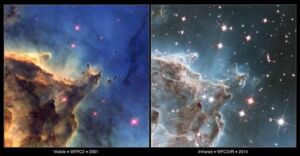Look Up! Featured Activity – Filtered Light

This content was written by Christine Shupla from the Lunar and Planetary Institute
Celebrate the first images of NASA’s James Webb Space Telescope with this featured activity: Exploring the Universe: Filtered Light.
Filters allow us to block some types of light and isolate others; separating out these different colors or energy levels of light can give us new information. In “Filtered Light,” participants discover how colored filters can help reveal more about an image. They can also make and study colorful images of their own.
Facilitate as an in-person program at your library, a Take & Make activity, or as a demonstration for a virtual program.
Time to complete: 10 to 20 minutes
Ages: 4 to adult
Modification and Preparation List
Total Cost: $25 plus printing (requires color gels and grease pencils)
Fundamental Space Science Concepts – Filtered Light relates to this Space Telescope’s First Images:
Exploring the Universe: Filtered Light demonstrates how the JWST can capture and filter different energies or colors of light to study the universe. This Space Telescope has instruments to examine the different “colors” of infrared light, to see very distant galaxies and to peer into the clouds forming new stars and planets.
Infrared light is not visible to our eyes but can be seen by special cameras and instruments. The telescope has cameras that will take pictures in infrared light that will help us to see objects that are hidden by gas and dust, like the stars and planets forming in giant clouds in the Milky Way and other galaxies.
Just like a prism can divide light into different colors that we can see, some of the instruments will spread out the light and measure the brightness of infrared light at different colors (or wavelengths), to make a spectrum of that light. This spectrum gives us additional information that can be used to help us measure the distances to the stars, galaxies, and clouds, which elements they are made of, and much more—hidden messages revealed by filtering the light!

Resources for you to use and share with patrons:
Elements of Webb: Elements Seeking Elements
JWST is designed to detect the elemental makeup of distant objects. In this 5-minute video, learn how this space telescope uses spectroscopy to investigate new worlds. Concepts are more appropriate for patrons ages 12 and up.
Introduction to the Electromagnetic Spectrum and Infrared Waves
These 5-minute videos provide an introduction to the spectrum and to infrared energy. Concepts might be more appropriate for patrons older than 10 years old.
How Do Space Telescopes Break Down Light?
This 2-minute video provides a brief overview of how Webb breaks down light into spectra. Downloads and transcripts available.
Insight into the Electromagnetic Spectrum
This 2-minute video introduces the electromagnetic spectrum–the distinct types of light– and how people, animals, and telescopes detect them.
Forms of Light: Electromagnetic Spectrum
This online interactive has an imaginary scene that highlights some of the natural and human-made sources of electromagnetic radiation on Earth and in space.
Discover more activities in the Look Up! First Image Clearinghouse Collection




Responses